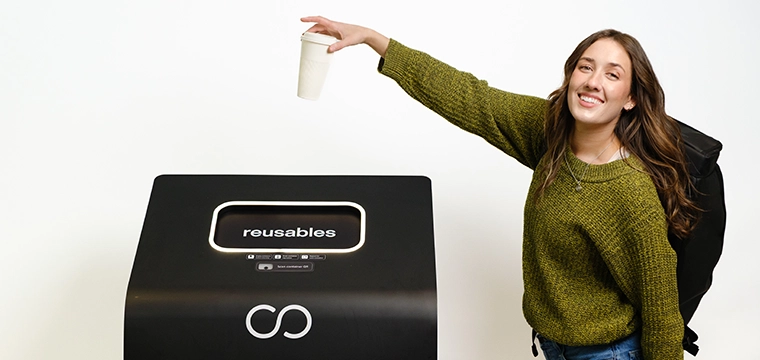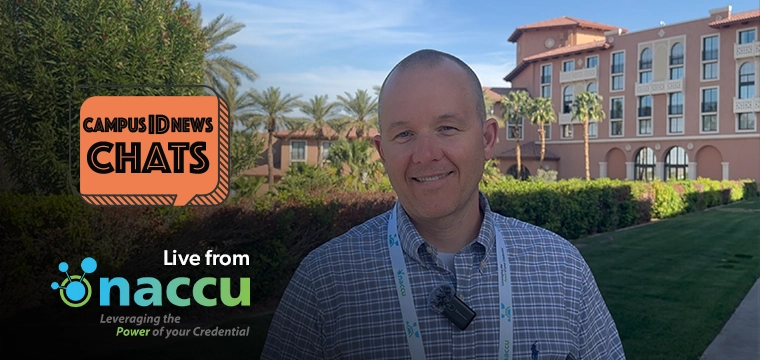Program director describes how card system enables lockdowns, coordinates with emergency personnel
In this episode of CampusIDNews Chats, Emily Dieker, Director of the GWorld Card Program at George Washington University, discussed the critical role her team plays in campus emergency response and lockdowns.
When she assumed the director role in 2019, she realized that despite having system capabilities to initiate lockdowns, the university lacked coordination among emergency personnel, her office, and other key departments. This gap motivated her to strengthen cross-departmental relationships and advocate for expanded system capabilities.
Initially, the card system controlled only 40% of external doors, but she helped get card readers installed on all external entrances, making rapid lockdowns a reality.
One of Dieker’s early successes was convincing leadership of the card system’s potential to make campuswide lockdowns possible. At the time, the system controlled only 40% of external doors, but she helped get card readers installed on all external entrances, making rapid lockdowns a reality.
She says that lockdown protocols are nuanced and situation dependent. Rather than locking down the entire campus during emergencies, GWU uses targeted lockdowns to isolate affected buildings while allowing others to remain accessible. This approach avoids trapping individuals outside and promotes safer sheltering strategies.
GWU uses CBORD’s CS Gold platform, which enables Dieker’s team to assign different privileges to different roles. This allows customized access so that police and emergency teams can initiate lockdowns but not unlock doors – ensuring security remains tightly controlled.
To listen to the full interview, click the image at the top of this page.
Transcript:
I would say my journey on this started when I became director of the card office in 2019.
We had lockdown capabilities for many years, but we didn't have the proper relationship with our campus emergency personnel, our police department, our emergency management team to really utilize it.
I'd been in the office in lower roles previously, but when I became director, it suddenly became my problem. And I became very nervous. This is what kept me up at night because I was like, what if there's an emergency?
If we need to lock down campus, you know, active shooter, violent situation on campus. Fortunately, we haven't had anything terrible like that happen, but we had some close calls.
And my concern was, am I making that decision?
Does anyone know that my system has the power, our card system has the power to respond to this and to help with this? So, when I became director in 2019, I tried to get people's attention on this.
I was very fortunate. I benefited from a new boss who I reported to who also oversaw campus safety, including police department and emergency operations team.
I raised it to that person's attention that said, hey, we can lock down. But by the way, we only control 40% of external doors on campus. If we controlled all the doors on campus, we could lock down the campus with a click of a mouse, a push of a button.
And that was the right person to tell that story to because a year later, we had readers on every single exterior entrance door to campus.
We didn't put readers on exit doors, but we put readers on every external entrance to campus so that we could lock it down.
And it started with that conversation and me having a scary talk with that person and saying, do you understand this risk?
I could talk also about the decision of what is a lockdown? So, you know, people think that, okay, are you locking all the doors? Or are you locking everybody out?
My leadership over the past few years, we've worked together closely to say that we don't want to lock down and lock everybody out unless there is a direct emergency in that place.
Say we have an active shooter on campus, we're not going to put, and again, we're a CBORD school, so the terminology for us is emergency mode, but the terminology for the general public, you know, is lockdown, right?
We don't want to put the entire campus into emergency mode because suddenly people who are outside are stuck outside and they can't get in. So, making everybody who's making these decisions and who works in emergency understand if there's an emergency, we're going to lock campus.
We're going to take every single door and we're going to push the button, which for us is the system button. We're going to go log in and say lock, and then we can lock in seconds.
And then if it's identified that, you know, building XYZ has a direct threat inside the building or directly outside the building, then we'll put building XYZ into emergency mode and we'll send out alerts saying don't go to building XYZ, seek shelter elsewhere.
So we work really closely on that protocol and helping our campus understand what that means.
There's been a big campaign from our emergency management team to say this is what we do in this scenario, this is what evacuate means, this is what shelter-in-place means, this is what run-hide-fight means.
So I'm getting them to define that all for the community and to give it out in safety trainings, in signage in the classrooms, in other places on social media.
They get it out wherever they can so that we can really make this common sense for our customers, our students, our faculty and staff, so that when that emergency happens, they're not having another freak out of okay, what do I do now?
We're giving them instructions that are clear and concise and they know the drill, they know what to do.
To get buy-in from other peers on campus via the police department, emergency management, maybe facilities that separate and does card access, I would recommend really trying to scare them, not in a bad way, but being realistic about if we don't work together and if we don't have a policy on how to lock down campus and we don't have a set procedure on how to do this, these are the consequences.
In an emergency, seconds matter and having the person properly trained so that when there is an emergency, you're not relying on one person. So have those upfront conversations with people, even if you don't have the existing relationship. I didn't have those relationships when I first came into my role, but I had to find the path to them.
But like I said, that's what was keeping me up at night and now it's other stuff keeping me up at night.
So, CBORD has been great for that. I can do it from my phone. I log into the VPN, I log into CS Gold. It takes 30 seconds at the most, but it shouldn't even take that long. I can do it from a desktop computer, but CS Gold, you can build it so that colleagues in other departments can have limited capabilities.
And so that was an important thing for us. Our emergency management team does not have full access to CS Gold, but they have full access to the lockdown module. Same thing with our police department. And when we were building that out, we said we want these people who help us in an emergency, we want them to be able to do emergency mode and we want them to be able to do lock mode.
We don't want them to do unlock mode because we don't want them to accidentally unlock anything. That's not their responsibility. Unlocking, we don't ever want somebody to just accidentally unlock them. We want unlocking to be a very thoughtful process.
And so having the ability to cut pieces of our system and say you can log into this part and you can't log into the other part.
We've actually worked with our police department and IT to have these are parts of CS Gold that the police department security operations center is supposed to be locked into at all times so that if there is an emergency, they can click these couple of clicks and it does what they need to do.
That has been a super powerful tool that I wouldn't be comfortable giving them if CBORD didn't give us the ability to limit their access and really customize what we wanted them to do.
In terms of who makes a decision in an emergency, we do have a matrix that our emergency operations team put together. I don't have that in front of me today, but it's basically, you know, for a lower-level emergency, it's like a police sergeant and higher. For a higher-level emergency, it is like a police chief or the VP who oversees both police and our team.
That's all documented so that I don't have the issue of someone calling and asking me to do this and then wait, do you have the authority to do that?
The idea is we give the people who have the authority to do this also the tools to do it themselves so that they can do this and they don't have to rely on me or another team member to answer the phone and do it for them.
We have an EMTF. Emergency Management folks love their acronyms, but EMTF stands for Emergency Management Task Force and that is a group of people leaders across all of campus.
From a student experience side, from an academic side, we'll have representatives from every school in that. We'll have representatives from athletics, law, representatives from facilities, and my team, and all of these other teams that keep campus running on a day-to-day basis.
If there's an emergency, if there's a power outage, a data center outage, a network outage, any of these smaller things or if there's a protest kind of effecting buildings or it's effecting students. Then we have a process to quickly pull together this team and say, hey, we're getting on a call in 25 minutes.
Everybody gets on. We've got an established e-room to meet in. And we all get on that and we all talk about, hey, what are the issues keeping operations going for your unit?
What about card access? What about dining? How can we still feed our students in that situation?
And so having the ability to pull together that group of leaders on campus and have a conversation and know that we have our time here at the table.




